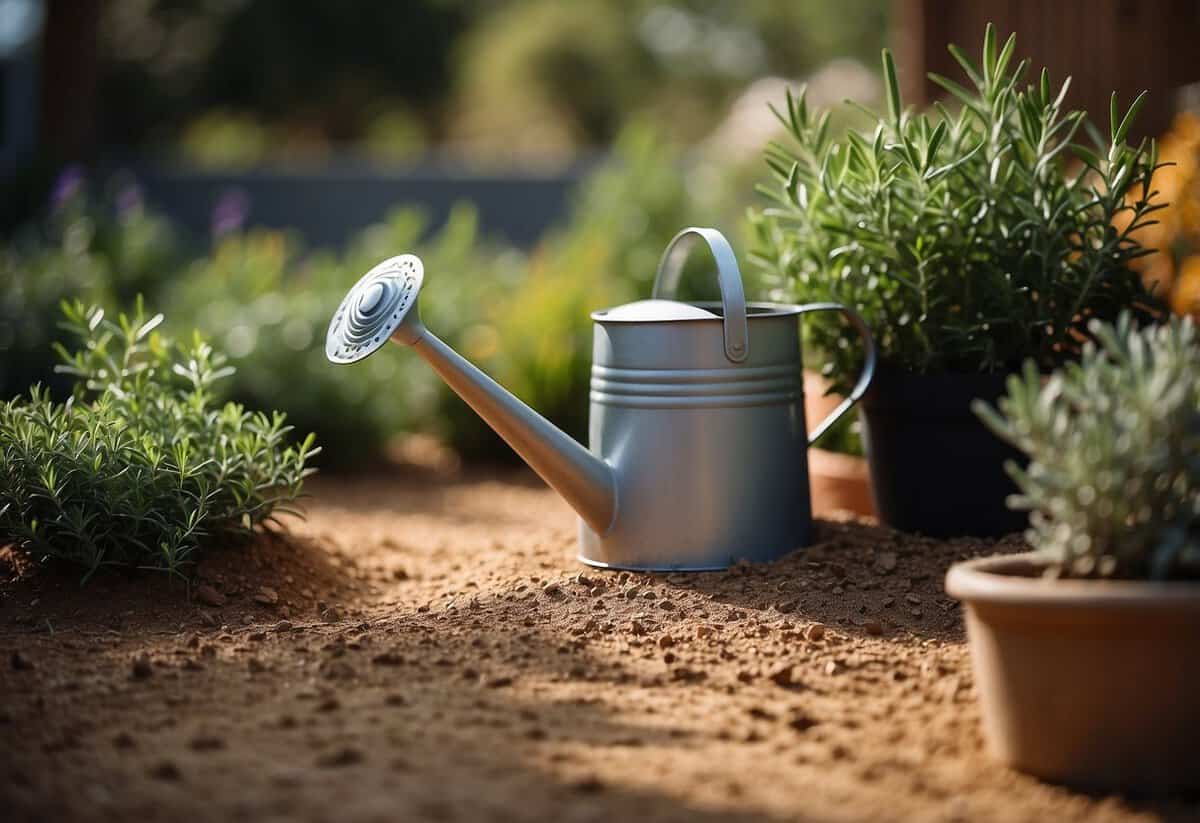Rosemary Garden Tips: Easy Steps for Thriving Herbs
Growing rosemary can be both enjoyable and rewarding, adding fragrance and flavor to your garden and kitchen. This versatile herb is known for its hardiness and the lovely scent it brings to any space.

Are you looking to discover simple and effective tips for cultivating a thriving rosemary garden? Whether you’re a seasoned gardener or a beginner, knowing how to care for rosemary properly can make all the difference. With just a little attention and the right techniques, you can grow healthy, lush rosemary plants at home.
1) Choose the Right Location

Pick a spot in your garden that gets plenty of sunlight. Rosemary needs at least 6 to 8 hours of direct light each day. Without enough sun, rosemary can become leggy and weak.
Plant your rosemary where it is shielded from strong winds. Wind can dry out the soil and damage the plant.
Ensure the soil is well-draining. Rosemary prefers sandy or loamy soil. If your garden soil is heavy clay, consider using a raised bed or a large pot.
2) Prepare the Soil Well

To grow healthy rosemary, start with the right soil. Rosemary loves well-drained, sandy soil with a pH between 6.0 and 7.5.
Use a mix of perlite, sand, or pumice to improve drainage. Adding organic materials like compost or well-rotted manure can boost nutrients.
Before planting, clear the area of weeds and debris. Loosen the soil to a depth of 8 to 10 inches using a garden fork or tiller.
3) Use Quality Rosemary Seeds

Choosing quality rosemary seeds is key to a thriving herb garden. Make sure to buy your seeds from a trusted supplier to ensure they are fresh and viable.
Good seeds will germinate well and grow into strong, healthy plants. Look for seeds that are well-packaged and have a good reputation for success.
Don’t forget to check the expiration date on the seed pack! Older seeds may not germinate as effectively, leading to disappointing results in your garden.
4) Provide Adequate Sunlight

Rosemary loves the sun. It’s important to give your rosemary plant at least six to eight hours of direct sunlight each day.
If you are growing rosemary indoors, place it near a south-facing window. This ensures it gets enough light. If this isn’t possible, you can use grow lights.
Outside, find the sunniest spot in your garden. Rosemary thrives in such locations and will thank you with its lush growth. Make sure to avoid shady areas.
5) Water Sparingly

Rosemary plants need well-drained soil. Only water when the top of the soil feels dry to the touch. Too much water can lead to root rot.
In dry regions, you may only need to water a few times each summer. In heavy clay soils, you might need even less.
Always be careful not to let the soil dry out completely.
6) Mulch to Retain Moisture

Using mulch can help keep your rosemary garden healthy. Choose mulch that helps retain moisture, such as coco fiber.
Apply a layer about 2 to 4 inches deep. This depth prevents water evaporation and still allows rain to reach the soil.
You can also use straw to help keep the soil moist. It’s easy to spread and adds a nice touch to your garden.
7) Control Pests Naturally

You can keep pests away from your rosemary garden with easy, natural methods. Try using homemade sprays like vegetable oil spray or soap spray. These are safe for your plants and effective against common bugs.
Companion planting is another great strategy. Pair rosemary with lavender or sage. These plants deter pests and grow well together.
Physical barriers, like nets or row covers, protect your plants without harmful chemicals. Additionally, sprinkle cayenne pepper on the soil to repel unwanted insects. This way, your rosemary stays healthy and pest-free.
8) Prune Regularly

To keep your rosemary plant healthy, it’s important to prune it regularly. Use clean, sharp pruning shears to trim your plant.
Start by removing any dead or damaged branches in late winter.
In spring, cut back one-third of the branches. Aim to leave one to two inches of leafy growth. This will boost new growth and keep your rosemary looking great.
After pruning, give the plant a light feeding of slow-release fertilizer and monitor for pests. For more details, check out these tips on how to prune rosemary.
9) Harvest at the Right Time

Harvesting rosemary starts with timing. The best time to harvest rosemary is in the morning after the dew has dried but before the heat of the day. This will ensure the highest concentration of essential oils.
Look for sprigs that have plenty of green leaves and no flowers. For the best results, use sharp scissors or pruning shears. Make clean cuts to avoid damaging the plant.
When removing leaves, you can either pluck individual needles or snip off whole sprigs. Gently run your fingers along the stem to strip leaves off. This ensures healthy regrowth for the next harvest.
10) Rotate Your Crops

Rotate your crops to keep your rosemary garden healthy. By changing the planting spots, you can reduce pest and disease problems.
Avoid planting rosemary in the same spot each year. Rotate it with other herbs like basil or thyme. This helps maintain soil nutrients and keeps your plants strong.
Read more about crop rotation techniques here.
Choosing the Right Location

Picking the best spot for your rosemary plants is crucial for their growth. They need plenty of sunlight and well-drained soil to thrive.
Sunlight Requirements
Your rosemary plants need a lot of sunlight. Make sure they get at least 6 hours of direct sun each day. Aim for a sunny spot, especially if you are growing them outdoors.
If you’re planting indoors, place your pots near a south-facing window. This spot often gets plenty of light. If you can’t manage that, you might need to use a grow light.
Be careful of shade. Too much shade can make your plants leggy and weak. Optimizing sunlight is key to strong and healthy rosemary growth.
Soil Conditions
Rosemary prefers sandy or loamy soil. It’s important that the soil drains well. Standing water can cause root rot, which is one of the biggest issues for rosemary.
You can improve drainage by mixing sand or gravel into your soil. Make sure the pH level is between 6.0 and 7.0 for the best results. If your soil is heavy clay, consider raised beds or large pots to help with drainage.
In a pot, use a soil mix designed for cactus or succulents. This type of soil is good at draining excess water, which helps keep your rosemary’s roots healthy.
Planting Rosemary

Planting rosemary is a key step to ensure your herb garden thrives. Knowing when to plant and using the right techniques are essential.
When to Plant
Rosemary grows best when planted in the spring, when the risk of frost has passed. For areas with mild winters, early fall is another good time. The plant needs time to establish a strong root system before winter sets in.
In colder regions, rosemary can be started indoors about 6-8 weeks before the last expected frost. This gives the plant a head start and protects it from freezing temperatures. Keep in mind that rosemary prefers temperatures above 50°F.
Make sure to maintain consistent warmth and light for the best growth. Using grow lights can help if natural sunlight is limited.
Planting Techniques
Rosemary thrives in well-draining soil. You can plant it directly in the garden or in pots. If planting in the ground, mix sand or gravel into the soil to improve drainage. For container planting, choose pots with drainage holes.
Start with small plants rather than seeds. Seeds can be tricky to germinate. Space the plants about 2-3 feet apart to allow them to spread and grow.
Water the plants thoroughly after planting, but make sure not to overwater. Let the soil dry out between watering. Using mulch can help retain moisture and keep the roots cool.
Pruning the tips lightly encourages a bushier, fuller growth. This makes the rosemary plant more robust and productive.
Caring For Your Rosemary Garden

Keeping your rosemary garden healthy involves proper watering and occasional fertilizing. These simple tips will ensure your rosemary thrives and remains fragrant.
Watering Tips
Weekly Routine: Water your rosemary every week and a half to two weeks if it’s planted in the ground. For container-grown rosemary, water once a week.
Soil Check: Before watering, check the top inch of soil. If it’s dry to the touch, it’s time to water. Rosemary prefers its soil slightly dry, so avoid overwatering.
Drainage: Ensure your pots or planting area has good drainage. Rosemary doesn’t like “wet feet,” which can lead to root rot. Use pots with drainage holes if planting in containers.
Fertilizing Rosemary
Frequency: Fertilize your rosemary once in the spring and once in the summer. Too much fertilizer can lead to weak growth.
Type of Fertilizer: Use a balanced, all-purpose fertilizer. You can also use compost or well-rotted manure. These natural options provide gentle, long-lasting nutrients.
Application: When applying fertilizer, mix it into the soil around the base of the plant. Be careful not to get fertilizer on the leaves, as this can burn them.
A little attention to watering and fertilizing will keep your rosemary plants happy and healthy. Enjoy the fresh aroma and flavor all season long.







